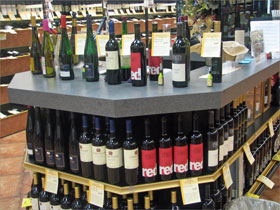Combine worse-than-expected after-work traffic, a cold drizzle and a broken umbrella. The unmistakable ingredients for a pretty miserable evening, right?
Wrong — not so miserable at all if once you arrive at your destination you’re greeted by a forest of wine glasses on top of pressed white tablecloths and cheery servers starting to pour — you guessed it — wine!
Welcome to a “Central Italy Wine Tasting,” I thought to myself on that dark and rainy night last week, glad that I wasn’t too late to miss any of the eight featured selections, gladder still after sitting down and immediately being served a 2005 Monte Schiavo Verdicchio Classico ($14.85). Delicately light and refreshingly fruity — the broken umbrella became but a distant memory.
The Verdicchio was soon followed by a 2006 Podere Canneta Vernaccia di San Gimignano ($13.99), just as fresh and clean as the one before it but laced with a surprising crispness. By this time, all of us at the table had made our introductions, as we began settling into a certain zone of contentment with smiles and nods all around.
Meanwhile, the host of this sparkling event, Laurent Guinand of GiraMondo Wine Adventures, a member of the Society of Wine Educators, was helping us interpret the varied aromas and tastes, and dispensing insights about the different terrains that conceived them. His cordially informative presentation alone would have been worth driving some distance in that crummy traffic and weather.
For wine lovers, the central area of Italy is a fabled land, spanning the regions of the Marche, Umbria, Lazio and, of course, Tuscany.
Charming towns, Roman ruins, cypress-dotted hillsides, ancient castles — producing, among other jewels:
- 2005 La Villetta Frascati Superiore ($14.85) — light, dry and balanced.
- 2005 Villa Puccini Chianti Riserva ($19) — an “excellent” Chianti, according to my notes, ruby-colored and dry but not biting.
- 2003 Vignabaldo Rosso di Torgiano ($9.99) — darker and more earthy than the Villa Puccini, “rustic,” as Laurent put it.
- 2004 Le Volte Tenuta dell’Ornellaia ($30) — I found it “lively,” the label called it “vivacious” — a mixture of Sangiovese, Cabernet Sauvignon, Merlot and Super Tuscan that seemed to leave everyone pleased.
- 2000 Lamole di Lamole Vin Santo del Chianti Classico ($22) — a very good year, Laurent noted, making for a very pleasant dessert wine.
- And last but definitely not least, a 1998 Rienzi Brunello di Montalcino ($65) — my personal favorite, with its layers of fruit and spice revealing, as Laurent suggested, what’s meant by the term complexity.
All in all, eight good reasons to attend a wine tasting.

 Writing a wine blog, of course, requires drinking wine. Not necessarily in large quantities, but enough to learn more and more about the varieties that different wine-growing regions produce, their distinguishing features, and how to enhance your enjoyment of them.
Writing a wine blog, of course, requires drinking wine. Not necessarily in large quantities, but enough to learn more and more about the varieties that different wine-growing regions produce, their distinguishing features, and how to enhance your enjoyment of them. During a recent vacation in Chincoteague, VA, that I blogged in a
During a recent vacation in Chincoteague, VA, that I blogged in a